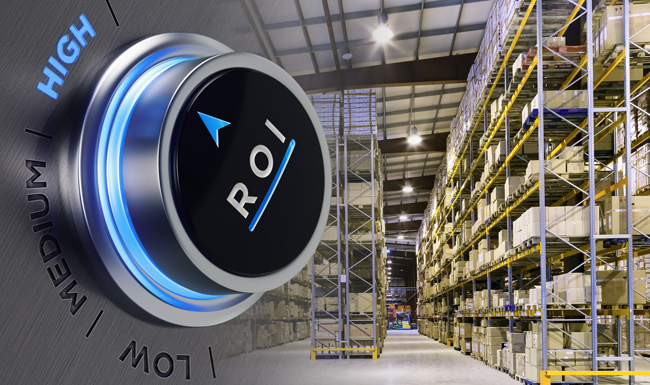
E-Invoicing and Its Geopolitical Stakes
France’s electronic invoicing reform relies on a Y-architecture, where Partner Dematerialization Providers (PDPs) play a central role in issuing and…
Generix Announces the Appointment of Olivier Vaillancourt as General Manager for North America View the press release

Figuring out return on investment (ROI) is a core exercise for anyone who is making an investment in software or hardware. “What’s the ROI?” is a common question that a warehouse or logistics manager will get when it comes time to justify a new software investment to corporate leadership.
A performance measure used to evaluate the efficiency or profitability of an investment or compare the efficiency of a number of different investments, ROI attempts to directly measure the amount of return on a particular investment, relative to the investment’s cost. To calculate ROI, the benefit (or return) of an investment is divided by the cost of the investment. The result is expressed as a percentage or a ratio.
Of course, ROI isn’t just about dollars and cents. There are other factors that must be considered in order to come up with an accurate estimate of exactly what a company will get out of its warehouse management system (WMS) or other supply chain software suite. Other key “wins” to factor into the equation, for example, include:
These and other points can be used to develop an accurate ROI for a new piece of software. “ROI is a popular metric because of its versatility and simplicity. Essentially, ROI can be used as a rudimentary gauge of an investment’s profitability,” Investopedia points out. “This could be the ROI on a stock investment, the ROI a company expects on expanding a factory, or the ROI generated in a real estate transaction. The calculation itself is not too complicated, and it is relatively easy to interpret for its wide range of applications.”
According to Forbes, the formula used to calculate ROI is:
[Gain on investment – cost of investment] divided by [cost of investment] = ROI
The cost of your investment is the amount of money you spend on implementing and maintaining your new software system, with the most obvious being licensing fees, tech support, and subscription service, Forbes points out. There may also be additional costs, including installing your new system, educating your staff about the upcoming switch, and training them on how to use the new system.
Gain of investment is the amount of money you stand to gain from implementing the new software system. For example, many health care providers and pharmacies have obligations to regulators. “If they don’t adhere to regulations, they may end up with a fine,” Forbes explains. “Many software packages offer safeguards to make sure companies adhere to all regulatory requirements, thus reducing the likelihood of these fines. The money you don’t pay out in fines would be a gain in investment.”
For clarity’s sake, Forbes says it’s always best to express ROI in relation to a period of time. Your ROI for the first month after you implement your software, for example, will differ from your ROI over the course of the year.
According to Explore WMS, defining the ROI of implementing WMS should be based on three factors:
“Think of your ROI on these levels, and you’ll start to see value as soon as you learn the functionalities of the WMS you select,” author Geoff Whiting explains. “When you begin to quantify them, you’ll often discover that you have more budget to invest elsewhere, can improve sales numbers, or are enhancing the work environment in ways that reduce turnover and attract high-caliber staff.”
Taking the time to define and understand expected ROI will also give you a better understanding of your vendor choice and change management practices, Whiting adds. It can also make your next software purchase more viable and productive. “You need ROI in the first place to know whether it is worth investing time and money in this new project or technology; and afterwards to double-check if the investment was worth it and meeting your expectations,” Datapine adds. “By looking at past investment choices and performing an ROI analysis, you can assess these decisions and make better costs projections in the future.”
Generix Group North America provides a series of solutions within our Supply Chain Hub product suite to create efficiencies across an entire supply chain. From Warehouse Management Systems (WMS) and Transportation Management Systems (TMS) to Manufacturing Execution Systems (MES) and more, software platforms can deliver a wide range of benefits that ultimately flow to the warehouse operator’s bottom line. Our solutions are in use around the world and our experience is second-to-none. We invite you to contact us to learn more.

France’s electronic invoicing reform relies on a Y-architecture, where Partner Dematerialization Providers (PDPs) play a central role in issuing and…

The B2B mandate in Germany, set to take effect on January 1, 2025, marks a crucial step in the European…

Following the October 15 announcement regarding the abandonment of the PPF development, the DGFIP and its partner AIFE are ramping…

Work with our team to build your ideal supply chain software stack and tailor it to your unique business needs.